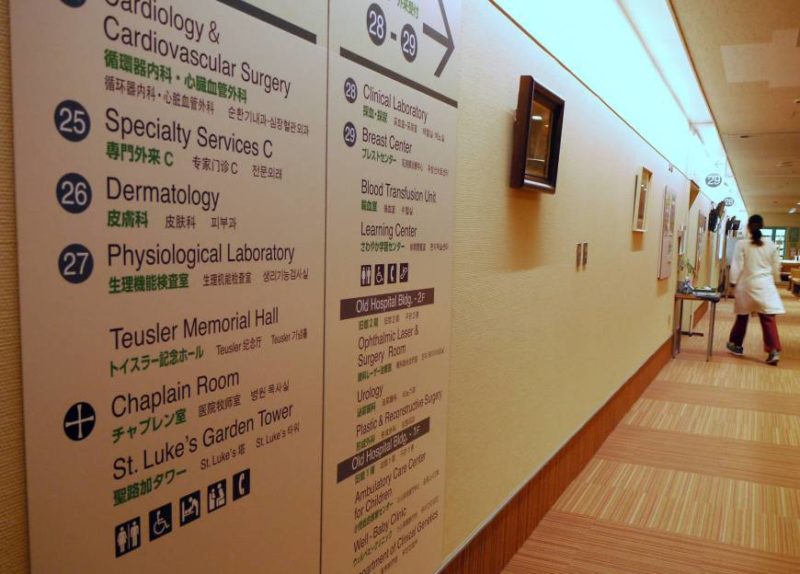Chinese people, especially in recent years, are leaving their homes looking for the best care available, or the best care they are desperately in need of. According to a Daxue Consulting study, at the end of 2016, around half a million Chinese citizens have left their country to seek a better medical experience overseas. The numbers are growing rapidly in the last few years, with travelers’ volumes estimated to be increasing at 31% annually since 2012.
The size of this market is worthy of note, it comprises the treatments expenditures, around $6.3 billion, and travel plus accommodation expenditures, around $3.4 billion. Therefore, in 2015, the outbound Chinese medical tourism worth a $9.7 billion business, with an average expenditure per capita of 50,000 RMB ($7,200).
Who is leaving China for care?

Source: www.japantimes.co.jp “An international hospital in Japan shows directions in four languages”
Even though this market is clearly in its early stages of development, the outbound Chinese medical tourism is already multi-faceted.
As pointed out by Daxue Consulting Project Manager Shawn Lou, the market can be divided up in terms of two key elements: essential and elective treatments.
The first ones are treatments for serious conditions, that cannot be treated in China due lack of drugs, insufficient surgeons with the necessary skills, or lack of technologies. Since these treatments are highly expensive and require advanced technologies and top quality facilities, only a few people can afford to pay this much. That is why only high-net-worth individuals, with a personal wealth of at least 10 million RMB, are the key customers in this segment of the market. Wealthy Chinese people, maybe affected with life-threatening problems, decide to have the best possible treatment, that often requires a trip overseas, mainly to United States of America hospitals or clinics, which are usually perceived by the Chinese as the best medical care facilities for treating severe illnesses in the world.
The second ones are treatments that don’t regard only medical treatments, but also healthcare services, covering a wide field of health-oriented, tourism ranging from preventive and health-conductive treatment to rehabilitation and curative forms of travels. These services are not necessarily highly expensive, but their costs can be beard only by Chinese of the upper-middle class. These people decide to spend money on healthcare according to their budgets; therefore, they look more to combine convenience and quality, looking for a comprehensive medical plan for their medical problems. This is why most of the elective treatments take place in China’s neighbor countries in Asia, drastically reducing the price of the trip.
Opportunities in the Chinese healthcare market
In 2009, the Chinese government implemented a $124 billion healthcare reform plan aimed at providing affordable treatments to the population. This reform encouraged private investments to build new hospitals and other care facilities, including 100% foreign-owned clinics. That is why many Chinese medical providers, both public and private, are now focusing on the West to help develop healthcare infrastructures, improve quality and provide expertise in operations management.
Improving the quality of healthcare infrastructure in China will reduce the costs, and it could help middle-class Chinese people to afford more serious treatments, while wealthy Chinese will continue to travel abroad, seeking the best treatment possible in the world’s top quality hospitals.
To cope with the increased number of patients seeking care abroad, China has spawned a new breed of medical tourism facilitators. They are led by visionary entrepreneurs who, in many instances, have invested their funds or attracted outside investment capital to grow their businesses to a level that was once thought of as off-limits for most facilitators. With a seemingly endless market of potential clients – many of whom are exceedingly wealthy – these facilitators can generate large patient volumes to send to overseas hospitals.
Among the people of the upper-classes is registered a new trend related to health insurances. More and more of these insurances are now designed to cover all the costs for overseas medical treatments, and wealthy Chinese desire to invest more and more money on their health and the health of their families. These insurances often are stipulated with medical tourism agencies, which are key players in this industry. They are an important part of the medical tourism market because they serve as mediators between the customers and the overseas hospitals or medical facilities, providing services and packages to assist and facilitate the overseas medical treatment trips. They help the future patience with all the bureaucratic paper works (visa, registration to the hospital or the clinic and accommodation), they assist him with the foreign language (a case that is very common when it comes to Chinese people), and they operate as the reference for the families.
Medical tourism agencies often have agreements or very well established relationships and partnerships with overseas hospitals, clinics, and medical facilities. Therefore, these agencies have the power to direct the customer’s flow to very specific targeted medical facilities.
Chinese Medical Tourism: untapped potentials

Source: www.mymedholiday.com – “Physical examinations and check-ups abroad are, together with severe illness treatments, becoming more and more popular”
China is the second largest economy in the world, and it has experienced in the last 30 years an unprecedented fast development. Even though it still is a developing country, for a great share of its population, all the basic needs have been satisfied, such as own a house and a car, have food every day on the table, etc., and now they are shifting their interests to more advanced needs. Due to the aging of the population and the increasing of the awareness related to health issues, the Chinese medical tourism registered a staggering growth.
The Chinese medical tourism is indeed already a big market, and it is growing quite fast but has to be pointed out that it represents less than the 1.8 percent of the total $551 billion spent globally on medical tourism in 2015.
In conclusion, it is possible to affirm that there are three fundamental ongoing trends that will drive Chinese medical tourism in the coming years: the widening of the market of high-net-worth individuals, the aging of the Chinese population, and the continuous increase of health and fitness awareness. In 2015, 30,500 Chinese were classified as millionaires (worth 10 million RMB and more), that is a fourfold increase on the 7,090 ranked in 2005, and they are expected to grow to 53,380 by 2025. By 2020, China’s rapidly aging population is projected to reach 240 million people.
The first two factors, combined with a stronger awareness and mindfulness of personal health, will definitively contribute to a further development of this industry, even if essential treatments are expected to grow at a slow pace (being very expensive) and elective treatments at a very fast pace.
To know more about the Chinese medical tourism market, contact our dedicated project managers by email at dx@daxueconsulting.com





